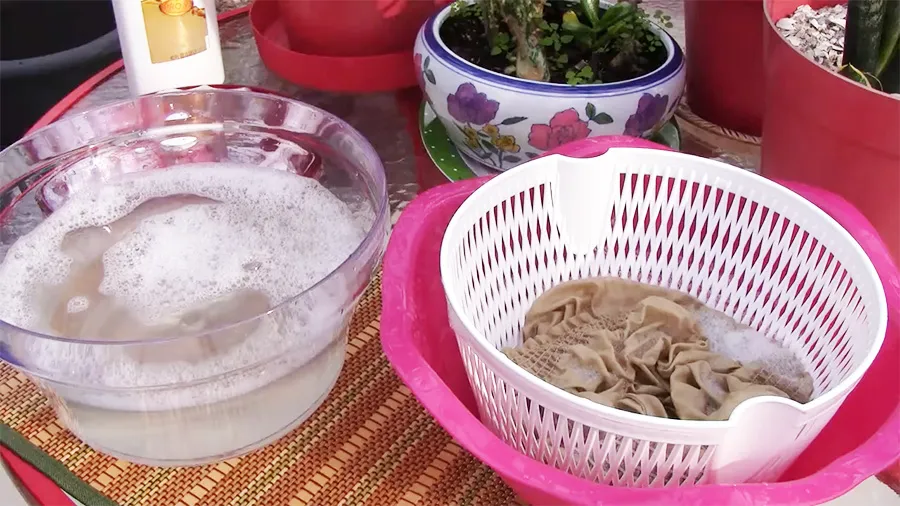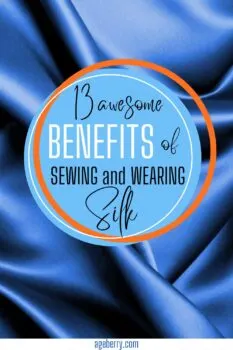In this guide, I want to show you how to wash items made from 100% silk fabric and how to prewash silk fabric for sewing projects.
Manufacturers of silk garments and bedding usually don’t bother to prewash the fabric they work with. That’s why they put labels saying “Dry Clean Only”.
But I highly advise prewashing the entire piece of silk fabric before cutting it. Of course, there are some exceptions to this rule. Don’t prewash home décor silk (which is usually heavier and wider) if you are going to use it for sewing curtains and throw pillows, and embroidered silk fabric which may not shrink proportionally.
I am against dry cleaning whenever possible because of chemicals even if it is organic. In China, they make silk fabric for at least 5000 years. And people cared for traditional silk garments long before dry cleaning. Silk is a tough fabric, it only appears to be delicate! It certainly can be washed in water.
Below you can see a painting of Robert Frederick Blum (American artist, 1857–1903) “In the Laundry”. It looks like they are washing silk garments.

Prewashing is necessary because silk fabric has one feature – most likely it will shrink after washing (in 90% of cases). So if you don’t prewash you may end up with the garment not fitting or draping the same after it has been cleaned. The fabric may even shrink when you iron it during construction and sewing. With prewashing, you also can avoid huge dry cleaning bills if you going to launder silk garments yourself.
✅ Related tutorial: How to sew silk
But not all silk fabrics and garments are equal. Prewashing (especially if it is not done properly) can take out the crispness of some decorator silk fabric, prints or colors can run (very rarely though for modern fabrics), and silk fabric can lose some of the sheens and may turn muddy (especially if you put it in a washing machine). So, in the end, it is your choice if you want to pre-treat silk fabric before cutting. As for me, I always do that and never had any problems.
Before you wash a garment
This article talks mostly about washing fabric; however, if somehow you need to wash something already made, a very important step is to read the laundry label on the item. Did you know that in the US only 35% of people read the laundry labels before washing them for the first time🤯? Read more about it here: Caring for Your Clothes: How To Read Laundry Labels.
Here are some rules for prewashing silk fabric
1. Fill a container with lukewarm water (30-35 °C, 86-95 °F ). You can add to the water a few tablespoons of distilled white vinegar or a few drops of a liquid hair conditioner. Don’t use your washing machine, most silk fabrics have to be hand washed. Of course, there are exceptions.
2. Gently push your fabric into the water and move it around a little so all the fabric is soaked.
3. Let it sit for 5 minutes or so.


4. Drain water, gently squeeze the fabric, put it on a towel and roll it up to remove water.

5. Air dry it, but not fully, it has to be a little damp before you iron it. Don’t place it to dry in direct sunlight or near heating elements. Machine drying is not recommended.
✅ Related tutorial: How to make a robe without a pattern from pure silk fabric
How to iron silk
Ironing silk is always delicate work. Iron (while it is still damp) without steam on the wrong side of the fabric. Test your iron first on a small side piece of fabric. Don’t slide the iron over the silk, or it may stretch the fabric or put it off-grain.
Usually, irons have special settings for silk but I found that the temperature of this setting is really very low. So I iron my silk fabric on the wool setting ( and some even on cotton) and never burned even sheer chiffon. The silk fabric is not afraid of a hot iron.
Satin and other shiny fabrics can be ironed on the right side, but it’s better to iron silk on the wrong side.
✅ Related tutorial: Best iron for sewing – all you need to know for choosing an iron for sewing and quilting


A long time ago I discovered that silk organza makes perfect press cloth. I made a shrug from organza to go with my wedding dress, but it was quite a lot of fabric left and I notice that it can be ironed at high temperatures and with steam without any problem. From the beginning, I even thought that I was misled and my organza is not real silk.
But I made burnout tests and the results were positive, I had organza from pure silk for sure. So I started to use this fabric as a press cloth and was never disappointed. The main thing is that I can clearly see through the fabric where I am ironing and I can easily avoid the awful creases that form sometimes and can spoil the whole garment.
Moreover, with organza as the press cloth, I am able to avoid those terrible watermarks that a steam iron sometimes produces out of nowhere.
So I highly recommend buying quite cheap organza silk fabric (well, really, it is not costly silk fabric somehow) and using it as a press cloth.

I have never seen 100% silk organza at a fabric store. I always buy silk fabric online. Here is an affiliate link where you can buy silk organza.
And now one more trick you can use. Sometimes you don’t even need to iron silk fabric or garments made from it, especially if the silk cloth is lightweight. Just hang it in the bathroom while you take a shower, and high humidity will take the wrinkles out of your silk right away. I live in Florida and I even can put my silk cloth outside ( not in direct sunlight ) when it is humid, and it is humid practically all the time here.
Anyway, it is best to always pre-treat your silk fabric using the manner in which you intend to care for the garment. This pre-treatment before cutting and sewing with ensure longer life of your garment.
How to wash silk garments and bedding
For our great-grandmothers, a satin dress or a chiffon blouse was pretty common (polyester was not created yet). They knew how to properly take care of them, cherished them, and wore them for a long time.
Now their experience is almost lost. How many silk garments do you have? And even if you have a silk dress or a blouse you don’t wash it, right? You go to a dry cleaner.
But if you can sew you can make as many silk dresses as you want and then you will need to know how to wash them.
Natural silk is not only delicate, but also expensive, so I’ll try to give some recommendations on how not to spoil your favorite silk garment by incorrect washing.

1. Natural silk fabric is not afraid of hot iron but is very afraid of chlorine. Therefore, never use chlorine-containing detergents. Use detergents for washing delicate fabrics. But the best detergent for silk fabric is shampoo or natural handmade soap. Silk in the composition is very close to our hair, but even more subtle and tender. So if detergents would damage our hair, then they would destroy silk fabric equally.
2. Try not to wash delicate garments made out of lightweight silk (like chiffon, georgette, crepe de Chine, charmeuse) in a washing machine (even if there is a delicate or manual washing mode). Handwashing is much better for these types of silk. The fibers of silk fabric in the wet state lose their strength and are destroyed by mechanical action. It is possible that from one wash in the machine those garments will not fall apart but it may happen after a few washings.
✅ Related tutorial: Types of silk fabric
3. Handwashing of lightweight silk garments can be done… in a salad spinner. No, I am not going crazy. And of course, I am not going to use the salad spinner to make food after that. But it is really great for washing silk scarves, shrugs, and blouses. Here is a small video on how I am doing this. Also, I soak the garment in warm water with some shampoo in it for about half an hour.


4. Wash and rinse the garment in warm water (30-35 °C, 86-95 °F ). When doing the last rinse add to the water a few drops of a liquid hair conditioner or white vinegar.
5. After washing, don’t squeeze or twist the garment. Let the water drain and put the garment on a towel and roll it up to remove water. Never put anything made of silk in a dryer. Let it air-dry.


6. Don’t let silk dry completely. Leave it a little damp for ironing. It can be ironed out perfectly only damp. If it’s damp you can smooth all wrinkles and creases that appeared during washing.


Did you find this tutorial helpful? If so, save this pin (see below) on your sewing board so you can come to this tutorial later when you are ready to wash or prewash silk and follow me on Pinterest for more tips, tutorials, and inspiration!
Like sewing tips? I have other popular tutorials on my site that might be interesting for you. Check them out below.

latest posts
- Knot a Problem: Easy Ways to Secure Short Thread Ends
- Ever Tried This on Your Serger? This Differential Feed Feature Will Amaze You
- Ditch My Sewing Machine? Not in This Lifetime!
- Adorable DIY Needle Book | Easy Tutorial for Beginners
- Master the Seam Ripper: Your Ultimate Guide to Precision Stitch Removal
- Think You Know Zippers? This Installation Guide Might Surprise You
- Why Does Your Seam Ripper Have a Red Ball? Discover Its Purpose!
- Topstitching Troubles? This Simple Trick Will Turn It Around Instantly!
- How to Sew Shirring: A Step-by-Step Guide to Elastic Thread Gathering







